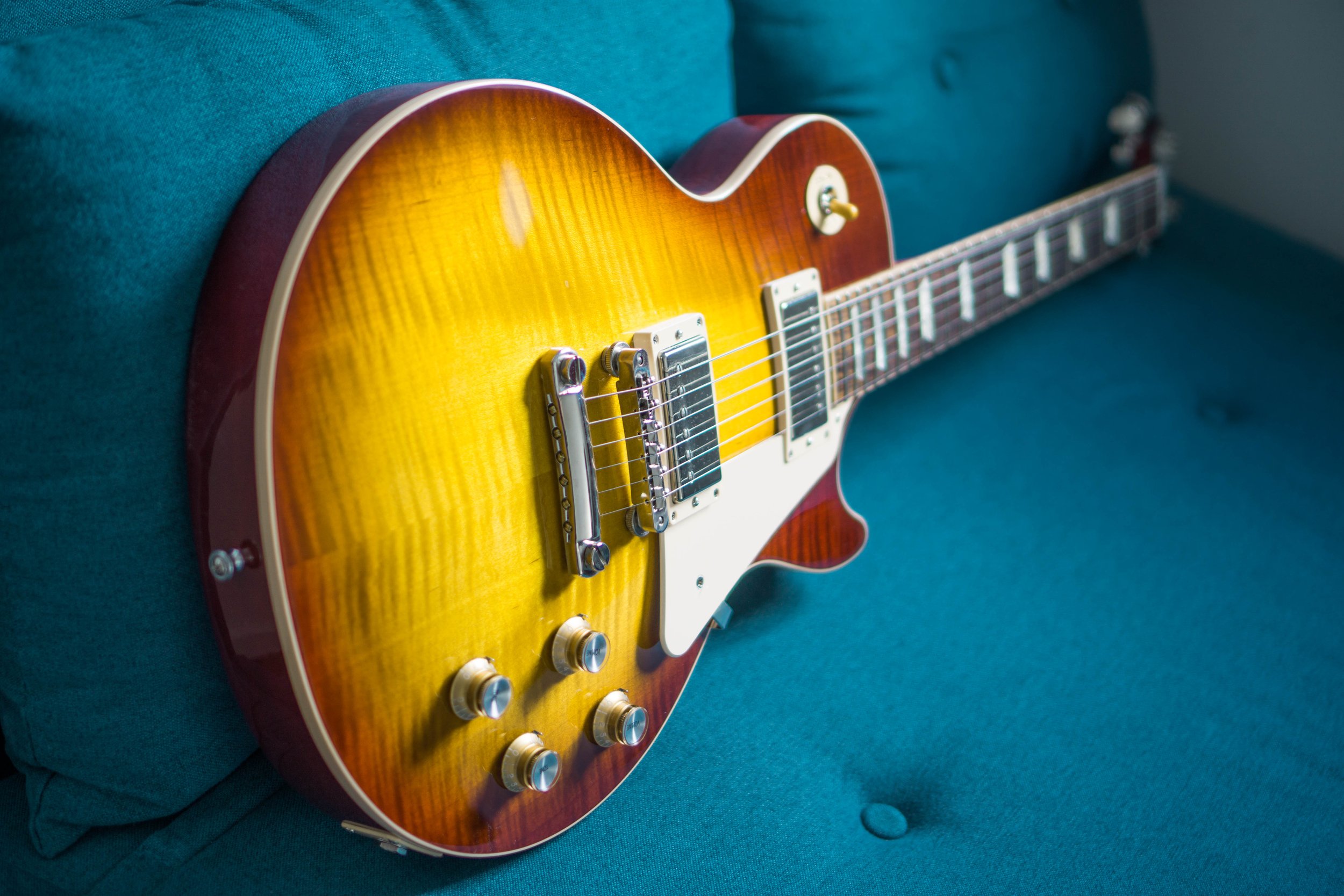Gibson Les Paul Standard 60s
‘The’ Les Paul.
£2299 at amazon.co.uk | £1977 at thomann.de
For over a decade, Gibson fans have been asking for the Les Paul Standard to be left alone and leave experimentation to other models. It did take a near-bankruptcy, but Gibson has finally done just that. The 60s Les Paul Standard is a production-line replica of the 1960 Les Paul.
The specs are looking good: no weight relief, Grover tuners, a fairly thin (for the era) neck profile, rosewood fingerboard and a AA-figured maple cap. The maple top on this one is very classy. Not quite the 5A flame maple you would see on a Les Paul Standard from 2018, but I think most players would prefer the understated look. It has a noticeably slimmer neck than the 50s model.
The setup was exceptional, especially given Gibson’s recent problems with quality control. The action was set very low out of the factory, with no dead spots. Combined with the 12” radius fretboard, this is a very fast guitar. Does that mean Gibson now produces instruments with the same attention to detail that we have come to expect from the likes of Paul Reed Smith? Unfortunately, not quite yet. The lacquer bleeds into the binding rather inconsistently throughout the neck - not a big deal. Other than that, everything seemed great upon first inspection. Having had this guitar for just over a year now, I am sad to report that the first fret inlay has started coming out. It doesn’t affect playability, but is very noticeable. Will see what Gibson Customer Support says about that… In any case, it is a rather simple fix to glue it back in, but not something you want to have to do on a £2,200 guitar.
The Burstbucker pickups in the Les Paul Standard are really good. You get very warm clean sounds and creamy distortion tones. The neck and bridge are paired very well, allowing you to seamlessly switch between pickups for extra bass or articulation during a solo. There are no coil taps or split, or phase switching, just like Les Paul intended. These options never worked well with Burstbuckers anyway, since they are too low output for a coil split.
So, what are the caveats then? Well, this is a return back to a very basic design with all of its original flaws. The headstock break angle makes the neck susceptible to breaking when pressure is applied. I had a brand new Les Paul Studio (in a gig bag) arrive with a pre-cracked neck not too long ago. The 3rd and 4th string break angle makes tuning stability sub-optimal. The use of a self-lubricating Graphtech nut was a good choice, as this alleviates the problem. I can’t say I have struggled with the tuning stability on my Les Paul. The weight can also be a problem for some. Mine is well over 4.3kg (almost 9.4lbs) and I start getting shoulder pain after about 30 minutes of playing while sitting down. Standing up with the right strap is actually quite comfortable, although you will still feel the weight after a 3-hour practice session.
Furthermore, Gibson bragged about lowering the price of the Standard model. I suppose that is true, but the 60s and 50s Les Paul Standards are basically a rebranded Gibson Les Paul Traditional (no weight relief, less figured maple caps and thicker neck profiles). It is actually a price increase if you compare the new Standard to the old Traditional models.
What alternatives do you have in this price range?
Heritage guitars will be a couple hundred pounds cheaper, also made in the U.S.A. and with better attention to detail, as well as some light aging. They will however suffer much worse resale value and have the same drawbacks of a 60-year-old design.
For almost half the price you can pick up a Gibson Les Paul Studio. It won’t be as flashy, but will have the same playability and vibe, while also benefiting from some weight relief.
In the PRS camp, you have the CE24 at a similar price point. The PRS will be simpler - natural binding, bolt-on neck. You will, however, get a more modern and ergonomic design, lower weight, locking tuners, unmatched attention to detail and more modern pickups. In a band/mix setting you could potentially prefer the Les Paul. For bedroom playing, however, the CE24 will almost always sound better (more articulate) and will be easier to play. The CE24 also offers coil splits. The 85/15 pickups are higher output, so coil splitting (removing one coil) is not a problem -- the resulting sound is still very good.
Then you have the non-U.S. brands like Maybach and Eastman that will make hand-made, reliced and vintage feeling instruments for quite a lot less than the price of a Les Paul Standard.
Do I love playing my Gibson Les Paul Standard 60s? Yes! Do I regret buying it? Hell, no! It is a fantastic guitar that plays and sounds great and is inspiring every time I pick it up. It is a design that has persisted for over 60 years and is not going anywhere.
At the end of the day, you are paying a premium for the Gibson logo on the headstock, but that’s ok. The Gibson Les Paul Standard is a very good instrument and a worthy alternative to Gibson’s Custom Shop reissues. As much as I hate agreeing with their advertising, if it is what you see yourself playing, then only a Gibson is good enough.





